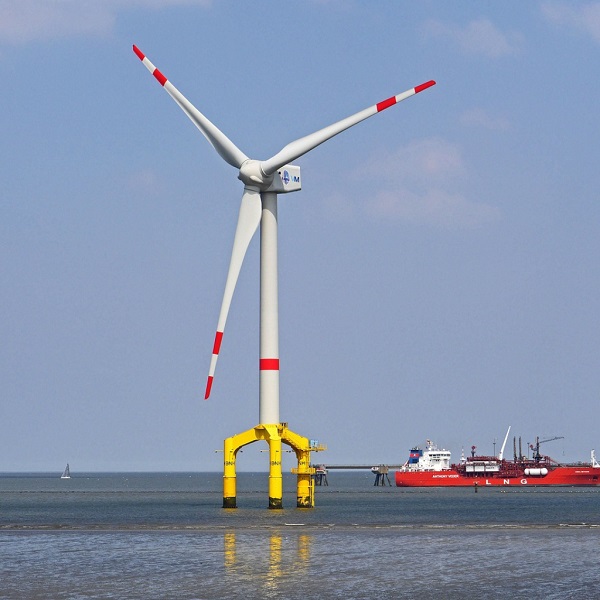New studies leveraging conceptual designs of offshore wind turbines point to how their drivetrains could change in the near future to produce more power while lowering costs, according to a new journal article by the U.S. Department of Energy’s National Renewable Energy Laboratory (NREL) and General Electric Research.
Barter is lead author of a new paper, “Beyond 15 MW: A cost of energy perspective on the next generation of drivetrain technologies for offshore wind turbines,” which appears in the August issue of the journal Applied Energy. He and his colleagues detailed how they designed conceptual offshore wind turbines to provide the fairest comparison among drivetrain technologies. The other co-authors from NREL are Latha Sethuraman, Pietro Bortolotti, and Jonathan Keller.
The drivetrain of a wind turbine is composed of the gearbox and the generator—the necessary components that a turbine needs to produce electricity. The gearbox is responsible for connecting the low-speed shaft attached to the turbine blades to the high-speed shaft attached to the generator. The drivetrain-generator configuration directly affects the overall performance of the wind turbine as well as the costs. The purpose of the research was to determine which drivetrain technology would be the most cost competitive as the size of the wind turbine increased and whether the answer is the same for fixed-bottom and floating foundations.
Wind turbines are powered by either of two types of drivetrains. One, referred to as geared, uses a generator connected to a gearbox, which can be a high-maintenance component because of its many moving parts. The other, a direct-drive, requires larger generators, which traditionally means bigger rare earth magnets that can be expensive. The study also considered direct-drive superconducting generators, which use superconducting magnets kept at very low temperature and do not rely on rare earth materials. This technology is commonly found in MRI machines but has not yet been industrialized for commercial wind turbines.
The current fleet of wind turbines off the United States coastlines can generate more than 40 megawatts of electricity, but the goal of the federal government is to increase that number significantly—to 30 gigawatts by 2030. Such a dramatic increase in deployment goals, along with market pressures, are pushing manufacturers to design larger, more powerful turbines.
The average offshore wind turbine capacity installed in 2021 was 7.4 megawatts, according to the Offshore Wind Market Report, and the number is trending upward.
Bortolotti said wind turbines with a 15-megawatt capacity are in various stages of development, but those adopting a direct-drive configuration require generators that “get very big and very heavy very quickly at these extreme scales. If we are really going to move beyond 15 megawatts, is a direct-drive generator going to be a burden? Is it going to be a bottleneck? And if so, are there alternatives or technologies out there that maybe we can switch to facilitate that kind of growth?”
To determine the optimal designs for more powerful turbines, the researchers conceptually designed three drivetrain technologies at five different powers ranging from 15 megawatts to 25 megawatts for both fixed-bottom and floating foundations. The use of software developed at NREL called the Wind Plant Integrated Systems Design and Engineering Model (WISDEM) allowed the researchers to create 30 unique design points.
The design with the lowest levelized cost of energy (LCOE) coupled a medium-speed gearbox to a permanent-magnet synchronous generator (MS-PMSG). The LCOE for this technology is estimated to be as much as 7% lower for both fixed-bottom and floating designs compared to a more common direct-drive configuration, provided the gearbox does not significantly increase maintenance costs. The analysis assumes that maintenance costs are identical across drivetrain-generator technologies and constant across the different power ratings, but LCOE is quite sensitive to maintenance costs. Between the PMSG and superconducting direct-drive solutions, the latter generated LCOE savings ranging between 2% and 5% depending on the rating. Superconducting generators were more beneficial in floating wind turbines than in fixed-bottom ones.
“With these design concepts, because none of these have actually been built, the medium speed looks pretty good from a levelized cost of energy point of view,” Barter said. “But if we start saying well, medium speed might have a higher maintenance cost than the direct-drive ones because there is a gearbox, we don’t know how much that increase in maintenance cost is going to be. Since we don’t know exactly what the difference is or what the maintenance burden of a novel superconducting generator will be, that’s where the caveat is. Superconducting generators raise similar questions around maintenance and reliability but also offer a promising alternative for direct-drive configurations.”
The non-NREL co-author on the paper is David Torrey from General Electric Research. The U.S. Department of Energy is partially funding the company’s efforts toward developing and building a lightweight superconducting generator. For deployment in deeper ocean waters, such as in some areas along the Atlantic Coast and throughout the Pacific Coast, wind turbines will need to be constructed on floating platforms and therefore weight becomes an issue.
“For floating offshore wind, the amount of weight that you have at the top of the tower is really critical to keep as under control as possible,” Barter said. “If we could develop some of these new generator technologies, maybe that would make floating offshore wind more economical.”
Source: Techxplore










